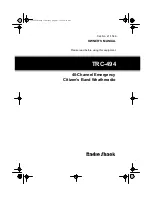
8
HOW YOUR RADIO WORKS
Traditional weather radios simply receive NOAA’s
weather broadcast (usually within a 50-mile radius)
then sound an alarm if any emergency code was
transmitted along with the broadcast. This means that
people who live outside an affected area are often
alerted even when their area is not affected, causing
many of them to ignore potentially real weather warn-
ings that can save lives.
In 1994, the National Oceanic and Atmospheric Ad-
ministration (NOAA) began broadcasting coded sig-
nals called FIPS (Federal Information Processing
System) codes along with their standard weather
broadcasts from stations in your area. These codes
identify the type of emergency and the specific geo-
graphic area (such as a county) affected by the emer-
gency. Your Weatheradio receives, interprets, and
displays information about the codes so you can de-
termine if the emergency might affect your area. Only
SAME-compatible weather radios (such as this
Weatheradio) are able to take advantage of this
new technology.
Each FIPS code identifies a specific geographic area
(defined by the National Weather Service), so your
Weatheradio sounds an alert only when a weather
emergency is declared in that area. This helps you
more efficiently track the weather conditions in and
around your area.
Summary of Contents for 12-250
Page 51: ...51...









































